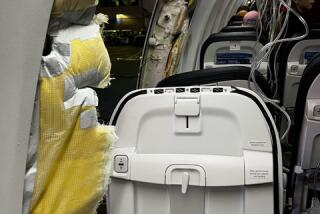‘I Called for the Emergency Destruct Plan’
- Share via
These are excerpts of comments by U.S. pilot Lt. Shane Osborn on Saturday in Hawaii, as recorded by eMediaMillWorks, a transcription service:
Question: Lieutenant, what can you tell us about the crew’s attempts to destroy the sensitive data on board? There’s been reports that some of the crew were back there with pickaxes physically destroying equipment. Can you tell us a little bit about that?
Osborn: At first impact, the aircraft pitched up and then rolled about 130 degrees angle of bank. I lost about 7,500 feet of altitude trying to get it out of that dive. . . .
The prop was fairly damaged, causing lots of vibration. There was a hole in the pressure bulkhead. So we lost pressurization. My nose cone was gone. And the aircraft was hard to control.
I lost my airspeed indication. . . . And I wasn’t quite sure of the rest of the damage at this point. We shut down the engine and could not hold altitude at 15,000 feet. It took until about 10,000 feet until it started holding altitude. At that time, I started discussing with my flight station. . . .
And we decided that we may be able to ditch, but we weren’t sure. . . . So, at that point, I called for the emergency destruct plan. I can’t go into any more detail than that.
Question: Could you describe what happened before the collision?
Osborn: Prior to impact, there was two times when the aircraft closed within three to five feet of my aircraft.
And then, the third time, his closure rate was too far. Instead of underrunning, he attempted to kind of turn and pitch up. And that was when his vertical stabilizer, where it meets the fuselage of the aircraft, impacted my No. 1 propeller, basically pretty much tearing his aircraft apart. And the front end came apart. I pitched up. And his nose hit our nose. And his tail went up, punched a hole through my aileron. That caused the--with the drag and the hole in the aileron, that is what caused the uncontrolled roll.
Question: Can you tell us a little bit about the captivity, the 11 days, and also, on the flip side of things, whether maybe you have anything nice to say about the Chinese, about the captors?
Osborn: Sure. Captivity was--they were polite to us and respectful. We were seen by doctors. . . . They obviously fed us--fed us well. And the only unpleasant part was the interrogations and the lack of sleep.
Question: In your opinion, is there anything that the U.S. has to apologize for in this incident? Or is it the other way around--does China owe us an apology?
Osborn: My opinion on what China does or doesn’t do isn’t important, but I’m here to tell you we did it right. No apology is necessary on our part.
More to Read
Sign up for Essential California
The most important California stories and recommendations in your inbox every morning.
You may occasionally receive promotional content from the Los Angeles Times.













